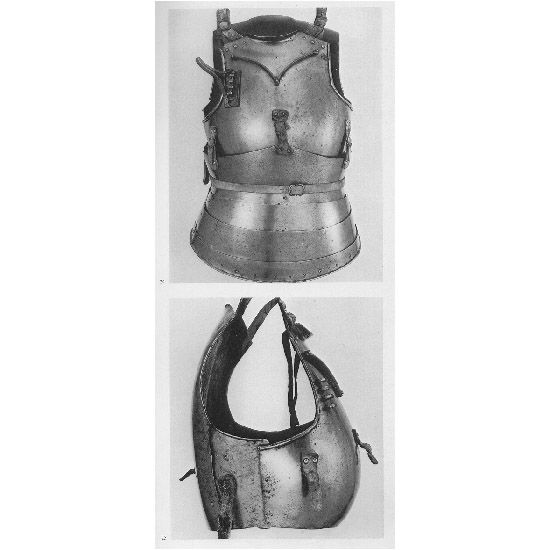Lately I though a lot about the developement of the backplate in the late 14th century and the early 15th century.
It is quite difficult to find something out about the developement of this part of armour compared to breastplates!
Most of the figures shown in medieval art are shown from the front and nearly all wear covering over the armour.
nontheless I found some original specimens and some sources in art which show different solutions for the armament of the back around the year 1400.
An example for an early style of back defence is the Churburg S 13 harness: [ Linked Image ]
Churburg S13 is usually dated around 1390
(also see : http://www.myArmoury.com/talk/viewtopic.php?t...urburg+s13 )
The earliest original full backplate I found was from the Churburg S 18 harness (attachment)
I don't know too much about the conventional dating of this harness. I read somewhere that it might be a composite harness, but if it isn't, I would put it in around 1410-1420, based on the gauntlets which turn up around 1410 and the armet which is shown in the Pisani-Dossi MS of Fiore dei Liberis "flos duellatorum" also dating around 1410 afaik.
There is evidence of the real backplate in manuscript illuminations from France and the german Countries around 1400.
( I will refrain from posting the pictures from manuscript miniatures directly here, the sides I linked contain all the information about the source of the illumination and it's dating and also it leaves this post free of too many images)
E.g.: http://vinschgau-urlaub.com/wp-content/upload...urburg.jpg
http://manuscriptminiatures.com/ab-urbe-condi...-261/2659/
http://manuscriptminiatures.com/de-mulieribus...98-2/2711/
and after 1410:
http://manuscriptminiatures.com/chroniques-m804/3216/
http://manuscriptminiatures.com/chroniques-m804/3233/
but also of backplates opening at the center of the back:
http://manuscriptminiatures.com/larbre-des-ba...-viii/654/
http://manuscriptminiatures.com/the-book-of-t...4431/1439/
http://manuscriptminiatures.com/the-book-of-t...4431/1432/
http://manuscriptminiatures.com/the-book-of-t...4431/1428/
or
http://manuscriptminiatures.com/bible-historiale-ms-9002/1947/
or even something like that:
http://manuscriptminiatures.com/des-cas-des-n...1902/3090/
or what seems to be very late coats of plate:
http://manuscriptminiatures.com/the-book-of-t...4431/1432/
left one
or
http://manuscriptminiatures.com/legends-of-th...3479/1905/
http://manuscriptminiatures.com/livre-des-mer...2810/2836/
http://manuscriptminiatures.com/livre-des-mer...2810/2834/
and of course, lot's of breastplates without backplates:
http://manuscriptminiatures.com/wenzel-bible-...2762/2776/
effegies are sadly and widely without use if one wants to research backplates :-(
sculpture from the second half of the 14th century show, AFAIK, the very same developement as the miniatures above.
Some show breastplates without backplates, like the St. George from the Basler Münster (ca 1380):
http://upload.wikimedia.org/wikipedia/commons...enster.jpg
or the Pistoia Altarpiece (1376):
[ Linked Image ]
and the St. George from Prague (1371) shows the brigantine back construction:
http://www.svjiri.wz.cz/images/sv_jiri%2010.jpg
I also read Bengt Thordemans book about the armour from Visby. If I remember correctly, he presumes that the real backplate developed together with the breastplate already in the 1380ies
Do you have any more ideas or sources?
I really wonder about whether there is any more (or newer) academical research on that matter, and what kind of backarmour construction really developed when?
Also I wonder about the popularity of the single breastplate without backplate and mostly without fauld
http://manuscriptminiatures.com/tafel-van-den...m691/3228/
I understand that it is a sensible choice for a mounted man. The cantle of the saddle covers the lower abdomen and the back is ssufficientlyprotected by mail if the main danger is a frontal lance thrust. But if a man thus armoured dismounts, he is much more vulnerable than a man with faulds or scaleskirt and backplate. I believe that this fashion was more common in Germany then in France, Flandres or England around 1400.
Best regards,
Till
PS:
I also found this very informative webblog... unfortunately after I found out most of these things on my own :D
Still a very usefull blog!

S 18 harness from Churburg